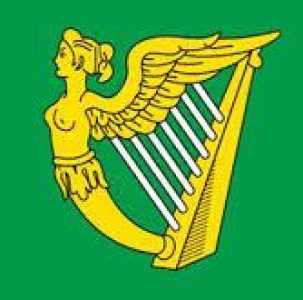The New York 69th Regiment is justly famous as the Irish Brigade. The 69th was often in the thick of the fighting and suffered horrendous casualties. The South also had its Irish Brigade. The Louisiana 6th Regiment was largely recruited from New Orleans. One of its recruiting centers was the Olive Branch Coffee House in New Orleans. Coffee houses in the ante-bellum days sold everything but coffee. But, they were places where business was often contracted. William Monaghan, a native of Ireland, conducted his recruiting for his company at the Olive Branch. He must have had a sense of humor. Mr. Monaghan was a notary in a city in which notaries drafted contracts and legal instruments. He was much better educated than the Famine Irish. Prior to the Civil War, New Orleans had by far the greatest number of Irish immigrants in the South. The New Orleans port was then the second largest in the country. The New Orleans port was then the second largest in the country. The fare from Ireland to the U.S. cost less for New Orleans than the Northern U.S. cities.
The Sixth Brigade was not completely Irish, but Irish constituted the largest number of enlistments by far. Of the ten companies in the Regiment, seven originated in New Orleans. The first colonel of the Regiment was Isaac G. Seymour, a newspaper publisher and Ivy League graduate. He was originally from Connecticut. He opposed secession. But, when war looked likely, he stepped forward to do his duty. The Crescent City had many “immigrants” from states north of Virginia. The booming economy had attracted many “Yankee traders” during the two decades before the war.
A Know Nothing Commander
The Louisiana Brigade was assigned to the Army of Northern Virginia. It included three regiments including the Sixth Regiment. Within weeks, Richard Taylor was assigned as the general of the Louisiana Brigade. Son of the former president, Zachary Taylor, Richard was a prominent sugar planter in Louisiana and a former member of the Know Nothing Party. Officially named the American Party, the Know Nothings seemingly grew overnight when the Whig party collapsed in the early 1850’s. The Know Nothing party quickly filled the gap with a virulent anti-immigrant fervor. The Know Nothings killed two Irishmen in New Orleans in 1854. Two years later, they brought in thugs from distant locales into New Orleans to suppress the Irish vote. They opposed all immigrants, but especially the Irish. There is no known evidence that Richard Taylor did not care for Irish, but he was active in the American party. That does suggest he agreed with the anti-immigrant fervor.
In December, 1861, Gen. Taylor executed two Irish soldiers, despite the plea of their commander. Executions were not unknown in either Army during the war, but they were not common either. These were the first executions in the Army of Northern Virginia. He was making an example of these two Irishmen and he said as much.
“Devil Thank ‘Em for That Same”
In May, 1862, the Louisiana Brigade was assigned to Gen. Stonewall Jackson in the Shenandoah River Valley. The Brigade did very well during the campaign, distinguishing themselves with a brilliant charge during the first Battle of Winchester. Gen. Jackson told Taylor his men had done very well. During the Valley Campaign, Stonewall Jackson was famously surrounded by three different Union armies. He succeeded only by ruthlessly marching his men far beyond the level of endurance for any sane man. In one long night march, so black that owls could not see their way, Gen. Taylor was marching with a smaller contingent of the Sixth Regiment. He was impressed with the tenacity of the Irish soldiers who never faltered, who often had to wheel around and fire at their Union antagonizers. The Irish and Taylor were executing one of the most difficult maneuvers in warfare, a rearguard action as Union cavalry stuck to their heels. Gen. Taylor would later say about the Irish, “They were steady as clocks and chirpy as crickets, indulging in many a jest whenever the attentions of our friends in the rear slackened.”
The Irish themselves would say about the long rearguard action that night, “It was a fine night intirely for diversion.” The Federals would gallop up, discharge their muskets at the fleeing Irish, whereupon, wrote Taylor years later, the Irishmen answered, “Devil thank ‘em for that same.” Gen. Taylor would write in his book years later that his heart warmed to an Irishman ever since that night.
Source:
James P. Gammon, Irish Rebels, Confederate Tigers (DeCapo Press 1998), p. IX, 41

The Union Irish Brigade was made up of more than one regiment. Whilst the CSA had a number of regiments with a high percentage of Irishmen in them, I don’t think any was actually an Irish regiment or brigade officially.
Do we know what the two soldiers were executed for?
LikeLike
Dennis Corkeran and Michael O’Brien’s offense was trying to help free some of their comrades from the brigade guardhouse. They were drunk at the time. Richard Taylor was viewed as a martinet about Army discipline at the time. Northern newspapers criticized this execution as overly harsh for a relatively minor offense. I expect many Confederates also viewed execution as over harsh. These two men were in Wheat’s Special Battalion. He asked for leniency, but Taylor wanted to make an example. It was said that Wheat sat in his tent and cried during the execution.
Thanks for stopping by.
Tom
LikeLike
Thank you, that does seem a very severe punishment for that offence
LikeLike
You bet, Simon.
Tom
LikeLike